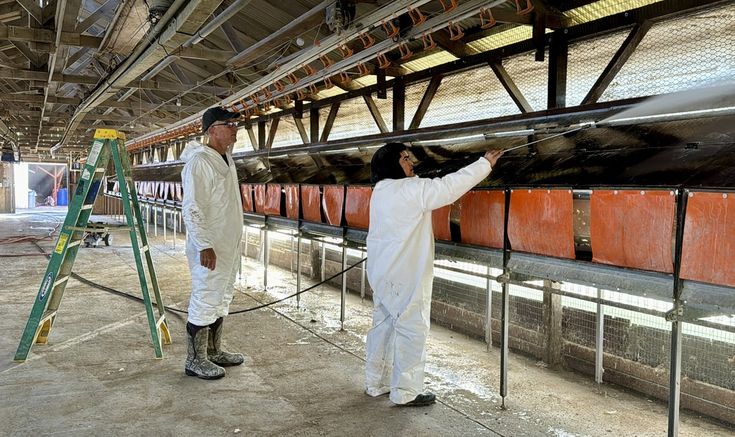In a significant public health update, officials have confirmed two human cases of the H5N1 avian influenza virus in Washington state. This news has sparked concerns among health authorities and the public regarding the possible impact on human health and bird populations. Grasping the characteristics of this virus, its modes of transmission, and the strategies being implemented to address the situation is essential for ensuring public safety.
Understanding H5N1 Avian Influenza
Avian influenza, often called bird flu, is a viral infection that predominantly impacts birds, especially domestic poultry such as chickens and ducks. The H5N1 strain of the virus is among the most pathogenic, attracting attention because of its high mortality rate in infected birds and its ability to infect humans. The World Health Organization (WHO) reports that the H5N1 strain has a case fatality rate of around 60% in humans, highlighting its status as a significant public health threat.H5N1 is not new; it was first identified in 1996 in geese in China and has since spread to various regions, causing outbreaks in wild birds and poultry farms across multiple continents. In recent years, there have been occasional reports of human infections, mainly among individuals who had close contact with infected birds. The recent cases in Washington state reflect this pattern, underscoring the ongoing threat the virus poses.
The Recent Cases in Washington State
The two confirmed cases in Washington state involved individuals with extensive contact with infected birds. Health officials from the Washington State Department of Health and the Centers for Disease Control and Prevention (CDC) reported that both individuals were quickly isolated and received appropriate treatment. They are in stable condition, and no further cases have been reported.
These cases highlight the persistent risk linked to H5N1, especially in regions where avian influenza outbreaks occur. Recent outbreaks among domestic poultry have been reported in several states, leading health authorities to enforce stringent biosecurity measures to safeguard birds and humans.
Transmission Pathways
Bird flu primarily spreads through contact with infected birds, droppings, or contaminated surfaces. The virus can also be transmitted through the air in areas with high concentrations of infected birds. Human infections usually occur among individuals who work closely with poultry or have been exposed to infected birds.
The recent cases in Washington state underscore the critical need for vigilance in monitoring and managing bird flu outbreaks. Although human-to-human transmission of H5N1 has been recorded, it is relatively rare. The main concern is the potential for the virus to mutate, facilitating easier transmission among humans and heightening the risk of a more significant outbreak.
Public Health Response
Local and federal health authorities are intensifying their surveillance efforts in response to the confirmed cases. The Washington State Department of Health is collaborating closely with the CDC and the U.S. Department of Agriculture (USDA) to monitor the situation and implement necessary measures to prevent the virus from spreading further.
Public health officials are carrying out comprehensive investigations to identify any additional potential exposures, especially in regions where infected birds have been detected. This effort includes testing birds in nearby wildlife and poultry populations to evaluate the outbreak’s scope.
Biosecurity measures are being prioritized on poultry farms, which include improved sanitation protocols, vaccination of poultry against avian influenza, and stringent quarantine measures for sick birds. These actions are essential for minimizing the spread of H5N1 among avian populations and preventing potential human infections.
Preventive Measures for the Public
Although the overall risk of bird flu spreading to the general public remains low, health officials advise that individuals who work with or around poultry should take specific precautions:
- Good Hygiene Practices: Regular handwashing with soap and water is crucial, especially after handling birds or cleaning cages. Alcohol-based hand sanitizers can offer additional protection when soap and water are not readily available.
- Personal Protective Equipment (PPE): To minimize the risk of exposure, people in close contact with birds should wear appropriate PPE, such as gloves, masks, and eye protection.
- Avoid Contact with Sick Birds: People are advised to avoid sick or dead birds and report any unusual bird deaths to local wildlife authorities.
- Seek Medical Attention: Individuals who develop flu-like symptoms after exposure to infected birds should seek medical care promptly. Early diagnosis and treatment are crucial in managing severe cases of bird flu.
Ongoing Research and Surveillance
Research on avian influenza is continuously evolving, with scientists examining the virus’s behavior and potential mutations and developing effective vaccines for both birds and humans. Surveillance programs play a critical role in monitoring the virus in avian and human populations, aiding in the early identification of potential outbreaks before they can escalate.
The WHO and CDC consistently monitor global H5N1 activity, offering updates and guidance to health authorities worldwide. As the threat of bird flu transcends national boundaries, collaborative efforts among countries are vital for sharing information and resources.
Conclusion: The Importance of Vigilance
The confirmation of two human cases of H5N1 avian influenza in Washington state highlights the persistent threat posed by zoonotic diseases. As health authorities strive to manage the situation, your adherence to health guidelines is vital for preventing the spread of the virus, providing a sense of security and guidance.
Alongside monitoring bird populations, educating the public about the risks associated with bird flu and the measures individuals can take to protect themselves and their communities is crucial. As history demonstrates, zoonotic diseases can have significant health consequences, making proactive measures essential for safeguarding public health.
Individuals are encouraged to follow announcements from health authorities and consult reliable health resources for more information and the latest updates on bird flu and public health recommendations. By staying informed and prepared, communities can effectively address the ongoing challenges of avian influenza and safeguard public health.

Leave a Reply to Hairstyles Cancel reply